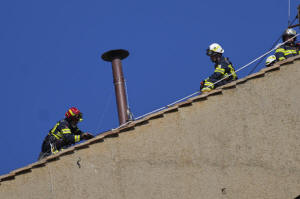Vatican firefighters install a chimney on the roof of the Sistine Chapel
for the papal election
[May 02, 2025]
By NICOLE WINFIELD
VATICAN CITY (AP) — Preparations for the conclave to find a new pope
accelerated Friday with the installation of the chimney out of the
Sistine Chapel that will signal the election of a successor to Pope
Francis.
Vatican firefighters were seen on the roof of the Sistine Chapel
installing the chimney, a key moment in the preparation for the May 7
conclave.
After every two rounds of voting in the Sistine Chapel, the ballots of
the cardinals are burned in a special furnace to indicate the outcome to
the outside world.
If no pope is chosen, the ballots are mixed with cartridges containing
potassium perchlorate, anthracene (a component of coal tar) and sulfur
to produce black smoke. But if there is a winner, the burning ballots
are mixed with potassium chlorate, lactose and chloroform resin to
produce the white smoke.
The white smoke came out of the chimney on the fifth ballot on March 13,
2013, and Cardinal Jorge Mario Bergoglio was introduced to the world as
Pope Francis a short time later from the loggia of St. Peter's Basilica.
Francis, history's first Latin American pope, died April 21 at age 88.
The chimney installation took place as cardinals arrived in the Vatican
for another day of pre-conclave discussions about the needs of the
Catholic Church going forward and the type of pope needed to run it.
These consultations include all cardinals, including those over age 80
who are ineligible to vote in the conclave itself.
In recent days, they have heard reports about the Vatican’s dire
financial situation, and have had the chance to speak individually about
priorities going forward and problems they identified in Francis'
pontificate.

Francis was a somewhat divisive pope, beloved by some for his focus on
the poor and marginalized, but criticized by others who accused him of
sowing confusion among the faithful on issues of morality and church
law. These conservatives and traditionalists, who are not believed to
have a majority among the 135 cardinal electors, are hoping a new pope
will reassert core church teachings and act as a stabilizing figure in
the Vatican bureaucracy.
Cardinal Beniamino Stella, who headed the Vatican office for clergy
under Francis until his retirement in 2021, has been among the older,
non-voting cardinals who has spoken during the pre-conclave sessions.
According to America, the magazine of the U.S. Jesuits, Stella this week
strongly criticized Francis’ reform of the Vatican bureaucracy that
allowed women and lay people to head Holy See offices rather than
clergy.
[to top of second column]
|

Firefighters place the chimney on the roof of the Sistine Chapel,
where cardinals will gather to elect the new pope, at the Vatican,
Friday, May 2, 2025. (AP Photo/Gregorio Borgia)

That reform, contained in a 2022 constitution, overhauled the
Vatican bureaucracy and fulfilled a key mandate Francis received
from cardinals going into the 2013 conclave that elected him pope.
But some have criticized the reform, which was nine years in the
works and sought to make the Holy See more service-oriented and
efficient.
Francis named two laymen to head the Vatican communications
operation and the economy ministry. More significantly, he named two
nuns to head two of the most important Vatican offices: Sister
Simona Brambilla as head of the Vatican office responsible for all
the world’s Catholic religious orders, and Sister Raffaella Petrini
as head of the Vatican City State administration. In that position,
Petrini runs the city state and is responsible for everything from
the Vatican Museums that provide the Holy See with most of its
revenue, to the firefighters who installed the chimney on the
Sistine Chapel Friday.
Their appointments were tangible evidence of Francis’ belief that
women should have a greater decision-making role in church
governance. But Stella, according to unnamed cardinals cited by
America, objected to Francis’ decision to separate the power of
governance in the church from the priesthood.
It is unclear what influence older cardinals such as Stella, who at
age 83 will not actually cast a vote, will have on the younger
cardinal electors. In general, cardinals of the more conservative
old guard have stresesed the need for unity over pursuing Francis'
more radical legacy.
“The pope has to ensure the unity of all of the church," said
Cardinal Fernando Filoni, the retired head of the Vatican's
evangelization office. "This is first and foremost. Everything else
comes after,” the 79-year-old cardinal said as he arrived Friday for
the pre-conclave discussions.
Cardinal Fernando Natalio Chomali Garib, the 68-year-old archbishop
of Santiago, Chile, said the variety of points of view was useful in
the pre-conclave meetings. Francis made Chomali a cardinal in
December after appointing him to head the Chilean church through the
continued fallout of the clergy sexual abuse scandal.
“For me, that I come from Chile, a far away country, hearing such
different experiences is an enrichment, not only for me but for all
of the church,” he said as he entered Friday.
All contents © copyright 2025 Associated Press. All rights reserved |